Menu
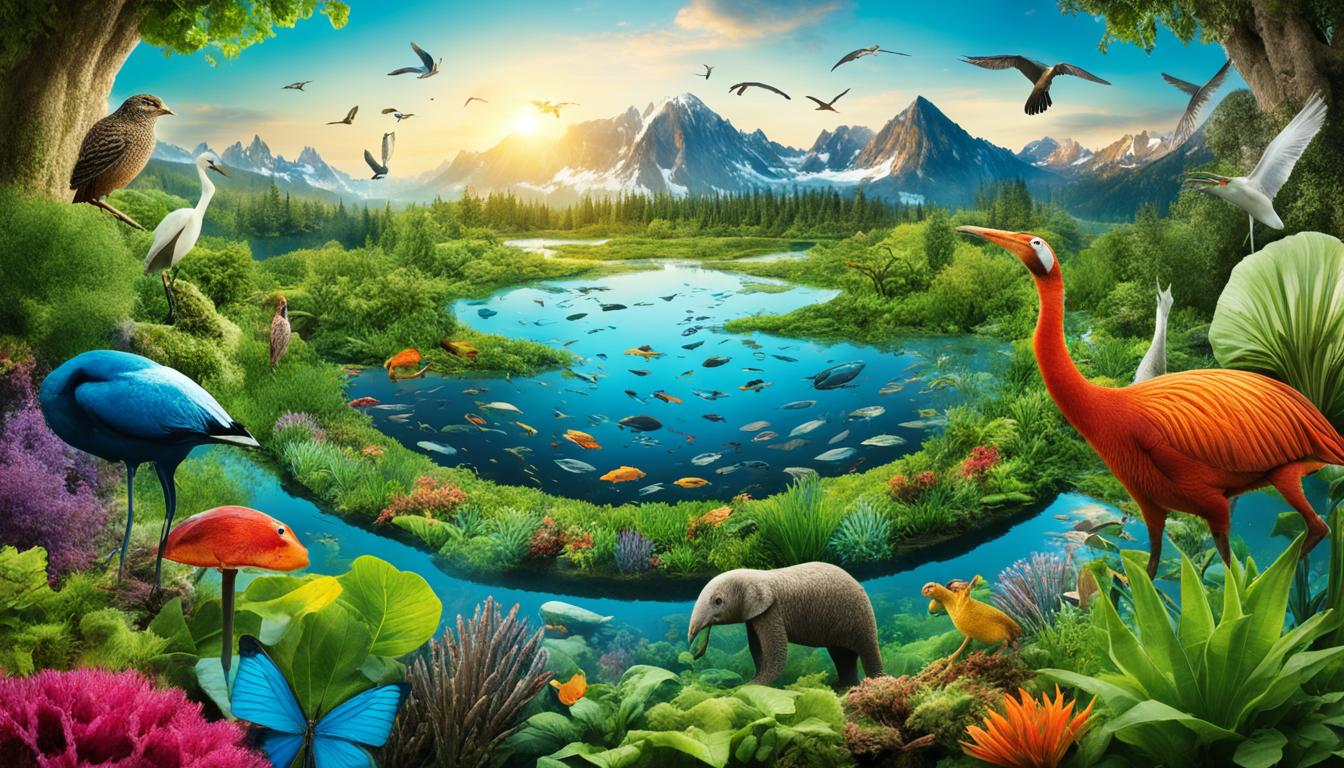
Thinking about our planet now, recent facts really hit hard. 2023 was the warmest year ever, showing how crucial it is to fight climate change. The world has lost 69% of its species since 1970. This isn’t just a number. It’s a clear sign we must save our biodiversity.
Stuart Lemmon, the head of EcoAct, looks to 2024 with hope. He says businesses must help fight climate change and save nature. Around half of the world’s money relies on nature. This links business success to keeping our environment safe.
Now, companies must act, not just choose to. The EU and UK have made new rules for businesses to be more sustainable. These rules help companies do good things for the environment and earn trust. EcoAct leads the way, helping businesses make the most of these rules. This improves how the public sees them.
Biodiversity is the wide range of life found on Earth. It includes many different plants, animals, and microorganisms, along with their environments. This variety is key for our planet’s health, human survival, and a balanced natural world. Knowing why biodiversity matters helps us protect it and keep the Earth healthy.
Biodiversity means the variety of life all over the planet. It describes everything from tiny forms of life to the biggest animals. This variety includes the differences in genetic make-up, different species, and the environments they live in. Keeping this natural variety is critical for the health of our ecosystems.
Biodiversity is essential for Earth’s well-being and for people too. It helps ecosystems to bounce back from harm. This is important for the planet and many things we need, like clean water, food, and stable climates. We rely on biodiversity for our health and wealth.
Biodiversity faces serious threats today. The numbers show a big drop in the world’s animal and plant populations since 1970. Our actions, such as destroying habitats and creating pollution, are causing harm. An example is Lake Victoria, where around 200 types of fish disappeared because of the Nile perch and other issues. Immediate, broad actions are needed to save biodiversity.
The problem affects our economies too, with more than half of global GDP depending on nature’s benefits. Businesses and governments recognise that losing biodiversity is bad for many sectors, like farming and medicine. Now, protecting nature is at the heart of planning for a better future.
In 2024, we see exciting new ways to save nature. These include using blockchain, eDNA, and farming that helps the environment. These methods will change how we protect Earth’s natural places.
Blockchain is not just for finance. It helps track animals and manage protected areas, making sure data is safe and everyone trusts it. For example, companies like Ocean Eye and InvestConservation are leading the way. They use small payments and digital tokens to help marine life and fund conservation.
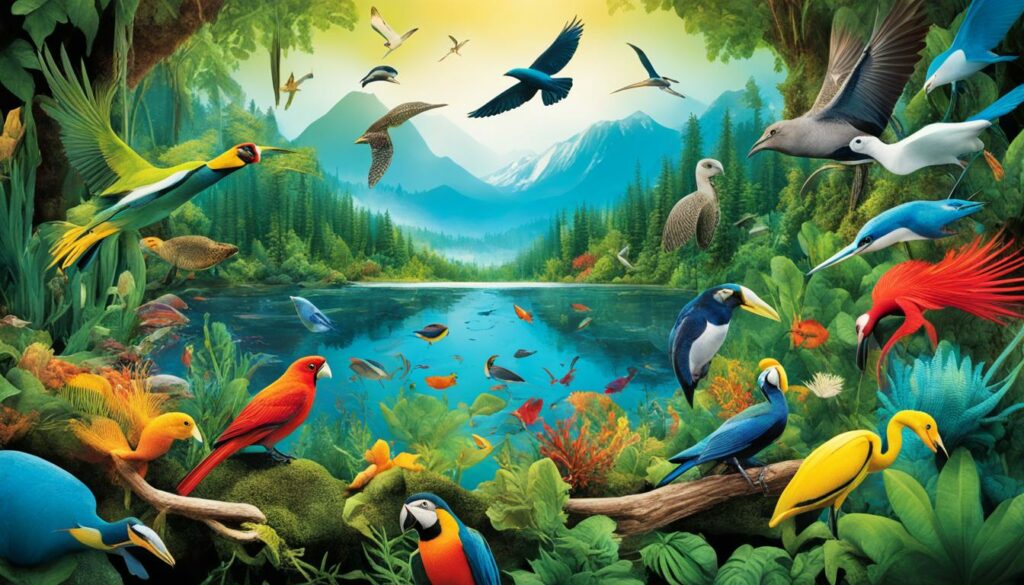
Environmental DNA, or eDNA for short, is a cool way to study wildlife without bothering them. By examining DNA left behind in the air or water, we can learn a lot about which animals are nearby. This helps predict future environmental changes, which is vital for keeping our planet healthy.
There’s also a growing interest in making farms better for the earth. This approach doesn’t just produce food. It also looks after the land and its living creatures. By choosing these farming methods, companies are becoming key players in protecting our planet for the long term.
Two more important trends are making wetlands healthier and promoting eco-friendly holidays. Restoring wetlands helps fight floods and cleans our water. Plus, eco-friendly trips not only protect natural areas but also help local people make a living.
In conclusion, with these new ways to care for nature, we’re taking an active role in protecting the future. By using the latest technology and smart planning, we’re making sure our natural world thrives for years to come.
It’s key to know the main reasons for losing biodiversity in 2024. We see climate change, habitat damage, exploiting species, and polluting the environment as big issues. These problems cause a major drop in the variety of life on Earth.
Climate change is a huge threat to life on Earth. It’s making the planet hotter and weather strange. This makes it tough for plants and animals to keep up.
More wildfires and smoke mean a harder life for all living things. The mix-up in the air is not good news for biodiversity.
Breaking down habitats is a big deal, too. Cutting down forests for farming and cities destroys homes for many creatures. Plus, in the UK, the lack of earthworms might be because we use too many pesticides. This shows how we’re hurting the web of life.
Using too many animals and hurting the environment make things worse. Fishing too much, hunting, and selling species illegally are big problems.
Also, factory pollution messes up homes for living things. Luckily, science can help, but we need to be careful not to make things worse.
New tech can check on soil and fix lands that have been ruined. But, we must all work together to solve these problems for our future on Earth.
The past year was big for sustainability rules, both required and chosen. New laws like the EU CSRD and the Nature Restoration Law are key. They help make sure businesses work in tune with nature.
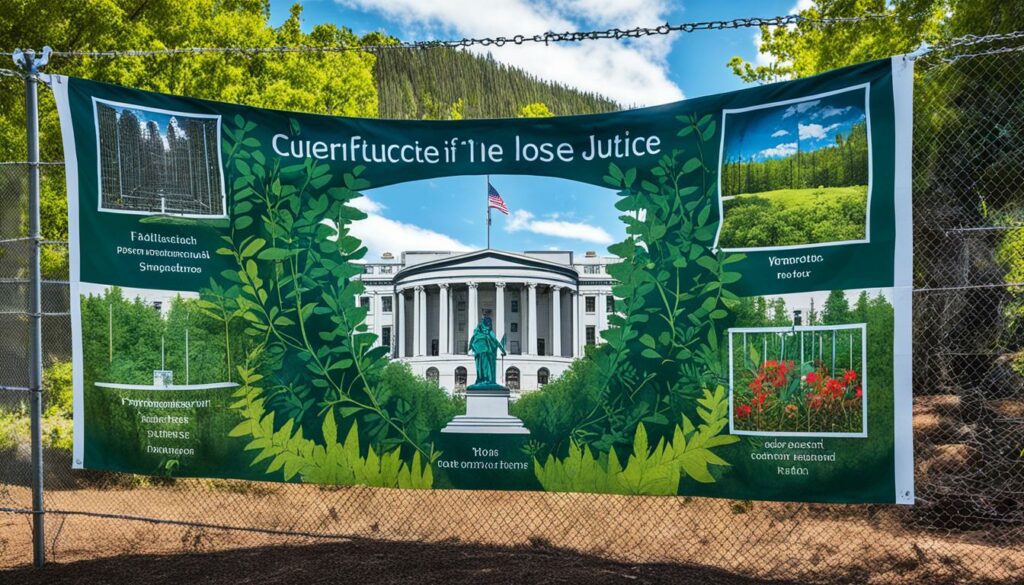
New laws are vital for protecting natural spots and the variety of life. They make businesses act in ways that don’t harm the environment. The CSRD, for example, makes companies share how they affect nature. This makes them more sustainable and earns the public’s trust.
Global pacts, like the Kunming-Montreal one, want to gather lots of money for nature. They aim to get $200 billion each year. This shows how working together is crucial to fill the big financial hole for nature, which is between $598–824 billion yearly.
Keeping track of how businesses use nature is now more important. New rules need detailed records on this. The TNFD and LEAP push companies to check how they affect nature closely. This not only shows who’s doing good but also urges companies to protect nature more.
Table: Key Biodiversity Conservation Frameworks
| Framework | Key Features | Impact |
|---|---|---|
| EU Corporate Sustainability Reporting Directive (CSRD) | Mandatory reporting on biodiversity impacts | Enhances corporate transparency and accountability |
| Kunming-Montreal Global Biodiversity Framework | Targets $200 billion annually for conservation | Mobilises significant global financial resources |
| Task Force on Nature-related Financial Disclosures (TNFD) | Establishes LEAP process for biodiversity risk assessments | Encourages comprehensive biodiversity evaluation |
| Transition Plan Taskforce (TPT) | Disclosure framework for business climate transition plans | Supports alignment with climate and nature regulations |
The world of biodiversity monitoring has seen big growth lately. We’re using new tech like AI, satellites, and data analytics to fight the decline in species. These tools are making it easier to gather and analyse data. They give us solid proof, helping us make better choices and take action effectively.
Biodiversity faces a 69% average decline in species populations since 1970, underscoring the importance of improved monitoring.
New conservation tech makes it easier to watch over the environment. With digital tools, we can keep track of wildlife in real time. This gives us insights into how animals behave and where they move. It helps protect their homes and gives advice to those who make decisions about our environment.
And, there’s more progress in environmental data analytics. These tools help us understand big sets of numbers about the environment. For example, EcoAct is using Climate Data Analytics to help solve climate and biodiversity problems. They’re finding ways for businesses to fight climate change and save energy.
The world is working hard to keep the promises of the Paris Agreement. We want to cut greenhouse gas emissions by 50% by 2030. But, many parts of the economy rely a lot on nature. It’s key to put money into high-tech conservation tools. This can help close the big gap in funds needed to protect biodiversity every year.
The Kunming-Montreal Global Biodiversity Framework (KMGBF) aims to raise $200 billion annually for biodiversity conservation, invigorating international efforts towards a sustainable future.
So, wildlife tracking and data analytics play a huge role in saving our natural world. They’re at the forefront of our plan to stop biodiversity loss. With these tools, we have a chance to make things right and keep our planet in balance.
Blockchain is changing how we protect our world’s species. It helps make everything clear and stops the selling of illegal animals. Plus, it keeps track of where money for saving animals is going. All of this is making a big difference.
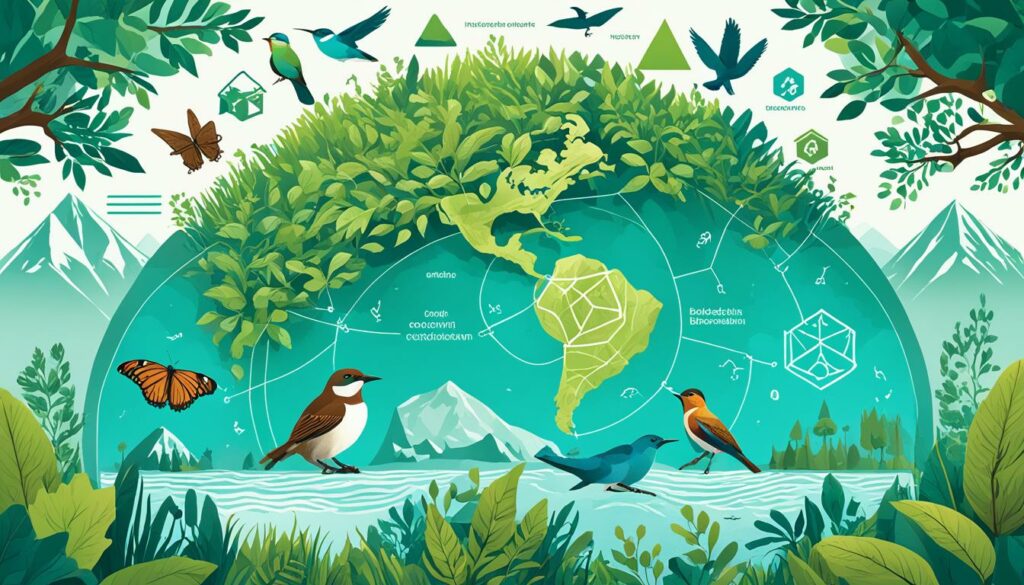
Blockchain makes everything clear in saving wildlife. It uses special records that can’t be changed. This means we can easily check where money and efforts are being used. So, people trust more, and we use resources better.
Blockchain is also fighting the illegal selling of animals. Ocean Eye and SEA use new ways to protect sea life, thanks to blockchain. It’s hard for bad sellers to do their trade without getting caught because blockchain keeps a clear, unchangeable record of animal movements.
Blockchain also helps keep money straight in saving animals. Anyone can see where the funds go thanks to clear records. This stops wrong use of money and makes sure it reaches the right wildlife-saving aims. InvestConservation in Switzerland is one good example of this.
Also, blockchain lets people and small groups look after their local wildlife data. This sharing and control of data help everyone work well together. It boosts how effective we are in saving different species.
Regenerative agriculture focuses on fixing soil and boosting life on farms. It’s key in farming that helps the environment stand up and thrive. Farmers use methods that work with nature to make their land rich again.
Regenerative farming tries to do as little harm as possible. It uses things like rotating crops and leaving the soil covered. These ways are great for the earth, helping it hold water better and support more life. Letting nature work in its own way, the land becomes strong and keeps on being good for growing food.
Regenerative farming does a lot for the variety of life living around. It makes soil alive and helps lots of different plants and animals to survive. This way, many types of life can find a home and live well. It also means using fewer harmful chemicals.
There are stories from around the world that show how regenerative farming works. In the United States, changes have led to better soil and farms that grow more. Places in Europe and India have shown the same success. These stories prove we can farm in a way that helps nature thrive.
| Region | Successful Practice | Impact |
|---|---|---|
| United States | Crop Rotation & Reduced Tillage | Enhanced Soil Health & Increased Biodiversity |
| Western Europe | Cover Cropping & Organic Fertilisation | Water Retention & Microbial Growth |
| India | Natural Pest Control & Diverse Planting | Improved Ecosystem Balance |
Wetlands are seen as key spots for biodiversity. Their revival is critical for saving nature. Efforts in wetland restoration do a lot for the planet. These efforts are only becoming more important, according to my study.
The StartUs Insights Discovery Platform found over 3,790,000 companies working on this. They are spread around the world, making waves in biodiversity.
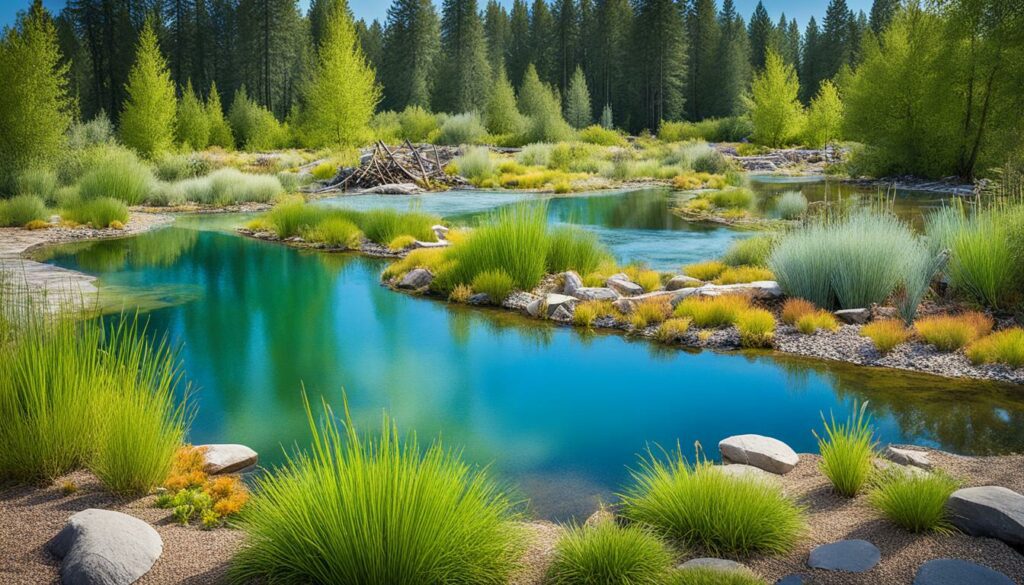
Most of these biodiversity startups are in Western Europe, the US, and India. When we include wetlands in our larger plans, we can help in many ways. This includes stopping floods, cleaning water, and saving many animals. Wetlands really do a lot for the Earth’s health.
Key Trends
Following these ideas helps not just damp areas but also in being ready for our future. It’s vital for the whole planet to pitch in. We need strong ecosystems to face what’s ahead.
Data is key in saving our planet’s rich life, boosting green data management’s impact. AI and large-scale data crunching are changing how we look after our ecosystems, ensuring their survival.
It’s vital to gather precise and up-to-date data to track life’s changes. With the year 2023 marking the hottest globally, we see a worrying trend. It’s now clear we must pursue smart, data-focused steps to protect our world. Luckily, nearly all of the Voluntary Carbon Market (VCM)’s size meets high standards, showing real commitment to clear and accountable actions.
AI and data analysis are essential for our natural world’s survival. They make it easier to watch emissions, save energy, and fight climate change. Now, it’s critical for companies to refine how they manage their environmental data. Such a focus isn’t just about tracking carbon but also ensuring biodiversity thrives. Imagine, since 1970, a massive 69% drop in animal and plant populations. It shows why we need cutting-edge solutions for our Earth.
Several real-life projects show how powerful data can be for lasting green change:
Using data smartly lets businesses and the public understand biodiversity’s ups and downs. It shines a light on why saving rare species is crucial, pointing at the big role of top-notch data analysis and AI in our fight for nature.
| Key Statistics | Indicator |
|---|---|
| Warmest Year | 2023 |
| Voluntary Carbon Market Coverage | 90% |
| Species Population Decline | 69% since 1970 |
Community conservation is key in saving our rich biodiversity. It depends on locals and their traditional know-how. By getting people in these areas involved, it uses their wisdom. This helps everyone take care of their surroundings better.
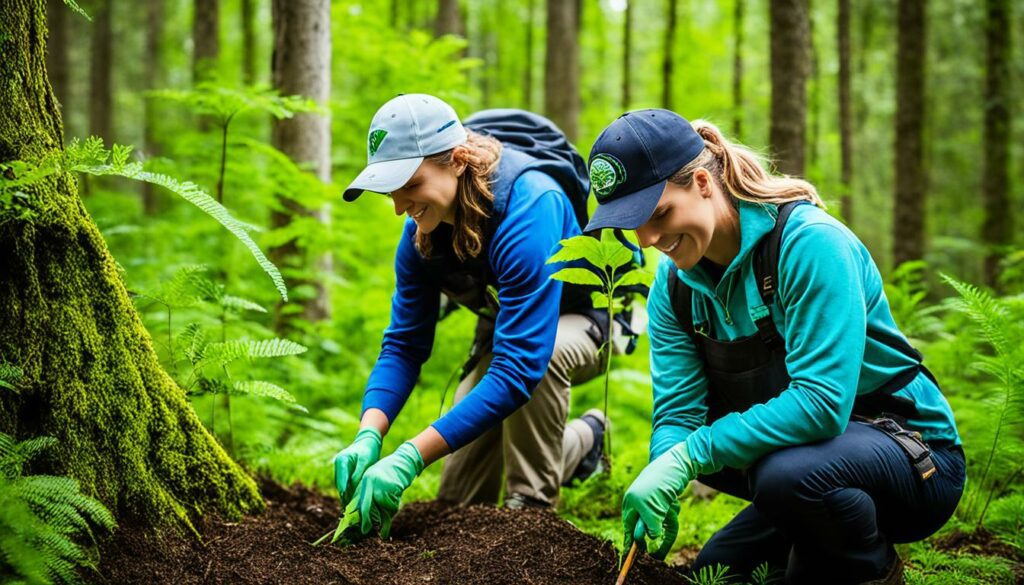
Making locals powerful is crucial for nature projects to work. Give them knowledge and the right tools for their area, and they do a fantastic job. These plans not just save nature, they make the whole community better off.
There are many tales of victory in global community conservation. Places like Nepal and Namibia show how important local care is. By supporting these parts of the world, we see new and smart ways to protect our planet.
Of course, there are hurdles, from lack of funds to politics in the mix. But these are chances to do better. We need to think out of the box, share what works well, and join forces worldwide. Together with the locals, we can beat the odds and win for nature.
Biotechnology is key in saving species and improving genetic diversity. It uses eDNA to watch over environments in a gentle way. This helps keep an eye on animals with shrinking numbers. It also uses advanced genetic techniques to help species at risk.
The use of biotech in protecting nature is on the rise. Studies show a lot of new companies are starting in places like Western Europe and the US. These companies work on new ways to take care of the planet.
One cool thing is how we can predict if a species is at risk. This helps us act before it’s too late. Companies like Trinity Agtech make tools to help farmers take better care of the land. They combine science and nature to keep our world healthy.
Saving DNA for the future is also very important. This way we can still use it even if some animals disappear. These methods are crucial for the long-term survival of various species.
Thanks to biotechnology, we have more ways to protect animals and their homes. It’s always growing, meaning we’ll be even better at looking after our planet in the future.
Ecotourism is a kind of travel that helps nature. It focuses on protecting wildlife and their homes. Travellers learn to love and care for these places by making small impacts and respecting local ways.
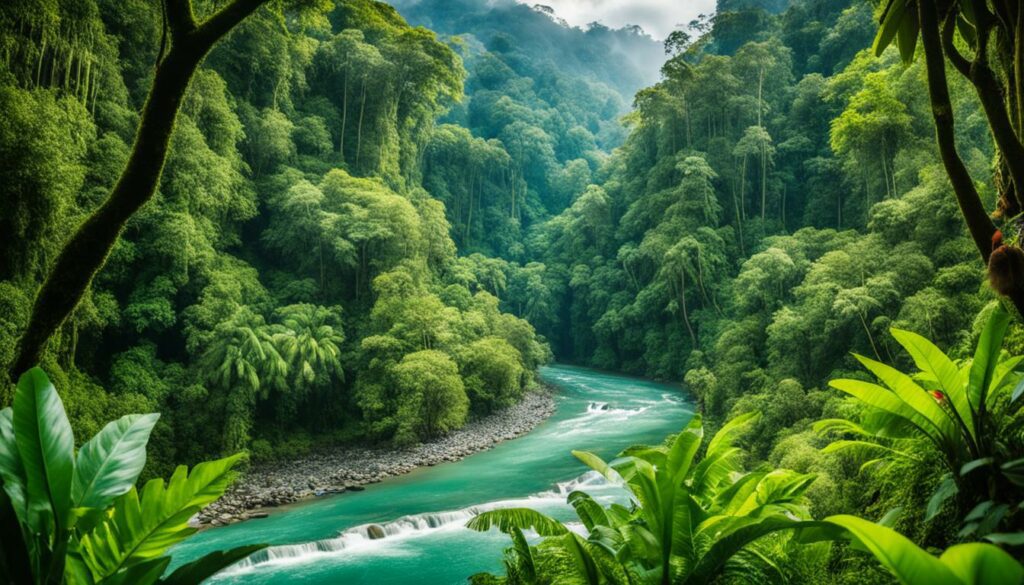
Ecotourism aims to keep the earth safe and cultures alive. It tries to do good, not harm. This means not hurting the places people visit, respecting the land and its people, and creating happy memories for everyone involved.
Ecotourism brings money that helps keep nature safe. This money goes into projects that save plants and animals. One way is by paying to use nature (like a small fee for taking pictures) that goes back into saving nature, making a win-win for wildlife and people.
Across the globe, many places use ecotourism to protect their environments. These include well-known spots like Costa Rica’s lush forests, Kenya’s famous safaris, and the Galápagos Islands’ unique creatures that attract scientists and nature lovers. Such places show how travelling the right way can help nature and people thrive.
Understanding how climate change adaptation connects to biodiversity is key. This way, we can make plans to keep our ecosystems strong. With the earth getting hotter (2023 hit a record high), quick action to protect nature is critical.
Climate change is causing a big drop in species numbers, by 69% on average since 1970. This harms the ability of ecosystems to fight back. It’s important to blend biodiversity with climate policies, especially since over half the world’s economy benefits from nature.
We need to ensure ecosystems can bounce back. This means protecting and fixing natural areas. Businesses are using tech and new ideas to lower their carbon emissions by 2030. This supports the goals of the Paris Agreement. Laws like the EU’s Sustainability Reporting Directive push businesses towards more green actions.
As the climate warms, saving biodiversity becomes urgent. Adapting our conservation work is key. By planning for biodiversity in a changing climate, we help ecosystems stay strong. This also fights against marine pollution that causes huge financial losses yearly. It’s clear that these steps must be a big part of our future plans.
| Key Statistics | Details |
|---|---|
| Warmest Year | 2023 marked the warmest year on record. |
| Species Population Decline | 69% average decline since 1970. |
| GDP Dependence | Over 50% of the world’s GDP relies on nature. |
| Biophysical Boundaries | Six out of nine boundaries for a safe operating space surpassed. |
The world’s need to work together to protect nature is very important now. Countries must come together to agree on rules and plans about nature. With everyone working together, it’s easier to protect the environment all around the globe.

In recent years, the world has seen new teamwork to protect nature. Back in 2023, a big group of companies and banks said they would follow new rules to help nature. They want to make sure their work doesn’t harm the environment. Also, a group called PRI began a project to show how important it is for companies and politicians to help nature.
Another project, Nature Action 100, brought 190 investors together. These investors want to talk to companies and make sure they’re taking care of the environment. This kind of effort helps keep everyone honest and makes sure money for nature is spent well. A new set of rules coming in 2024 will help everyone work together better to help nature.
Smart partnerships are also making a big difference in protecting nature worldwide. For example, InvestConservation uses special tech to make sure that money for nature goes to good projects. Also, a project in Finland lets people pay small amounts to see sea life. This way, everyone can help take care of oceans.
In 2024, Colombia will hold a big meeting, COP16, to talk about how to protect nature. This is an important chance for everyone who cares about the environment to get together. They’ll share ideas on how to make sure nature stays safe. This meeting is a big part of working together to save our planet’s different animals and plants.
We need to focus on adding biodiversity to our global goals for a sustainable future. New and cool ways to be sustainable are key to saving our planet. The need for good nature data proves this effort is urgent.
Adding biodiversity to the Sustainable Development Goals is picking up speed. The UN says we have to increase funds for nature by 2025. By 2024, the Global Biodiversity Framework wants to raise $200 billion yearly for biodiversity funding. This shows biodiversity is critical to reaching our goals.
Projects like eBioAtlas are using eDNA tech for a global life map. This shows how we’re working together to protect our planet.
Creating new ways to be sustainable is essential for our future. NatureMetrics’s Intelligence Platform helps groups learn more about their ecosystems. This leads to better decisions based on solid data.
Plus, 320 top businesses have promised to be more open about their impact on nature. This is a big move toward being responsible and clear.
Planning for our planet’s future needs bold action. Important suggestions are expected from the IAPB at COP16 in Colombia. A worldwide ban on plastic pollution could be completed by 2024, pushing for $65 billion a year into a circular plastic economy by 2040.
The TNFD report confirms the growing need for nature data. This points to the importance of strong plans for the future. Adding biodiversity goals isn’t just an option – it’s a must for a healthy planet for all living things.
In 2024, saving our planet’s rich life needs complex plans. The Kunming-Montreal Global Biodiversity Framework aims to raise $200 billion yearly for nature. Yet, we’re short by $598–824 billion every year.
Technology is key to our fight for nature. Things like AI, satellites, and data tools help us watch and understand nature better. They help make sure money is spent right, keeping things clear.
This era also sees new ways to protect nature financially. A market for companies to pay for their natural impact is growing. Plus, the UK and others are starting to list nature’s value in laws, pushing businesses and countries to care more.
Looking forward, tech, laws, and everyone’s help will decide how green our future is. We need to gather resources and meet big money needs for a greener change. Even with many hurdles, global efforts, smart ways, and money promises a hopeful way to protect our world’s life for future people.
Biodiversity means the wide variety of life on Earth. It includes different species, their genetic makeup, and various ecosystems. Biodiversity is key for keeping our planet healthy. It supports our lives and keeps nature in balance.
Biodiversity is vital for many things we do. It helps pollinate crops and purify water. It also keeps our climate stable. Plus, it’s great for holidays and fun activities. This all makes life better for everyone.
Climate change is a big threat. So is cutting down forests and growing cities. Hunting and fishing too much, and pollution from factories are also major problems. They harm many species and their homes.
Blockchain makes records safe and hard to change. This can help stop illegal trade in animals. It also tracks how well we look after nature. Plus, it lets more people use important environmental information. And, it makes sure money for saving nature is used wisely.
Regenerative farming improves soil and helps more kinds of plants and animals grow. It avoids disturbing the soil much and changes crops regularly. These methods help nature and make farms more sustainable. They also bring more life back to the land.
New tech, like smart computers and online tools, help us study nature better. This makes it easier to measure how well places are looked after. It also helps companies use less energy and work more sustainably.
Strategies to deal with climate change also help nature survive. They make sure animals and plants can withstand tough changes. These steps help protect our natural world for the future.
Ecotourism puts money into saving wild places. It’s about travelling in ways that help nature, not harm it. This way, places worth seeing stay safe. It also helps local people have better lives.
Certain laws and guidelines, like the EU’s reporting rule and nature finance advice, help businesses be more eco-friendly. They show companies how to follow Earth-saving rules. Using these helps nature and gives companies a good name.
With high tech like AI, environmental problems are tackled better. This tech helps cut pollution, save energy, and get ready for climate change. It’s proven to make our world cleaner and safer.
When local people take care of their area, it works well. They already know a lot about living with nature. Getting everyone in the area to help makes a big difference. This way of caring for nature can be copied and used globally.
People from around the world working together is key. They push for more nature reserves and big efforts to save animals and plants. Everyone working as one is best for saving our Earth’s variety of life.
By using blockchain, eDNA, better farming, and AI, we’re doing more to save nature. These new ways show that we want to keep our planet healthy. They aim to protect life in every part of our world.